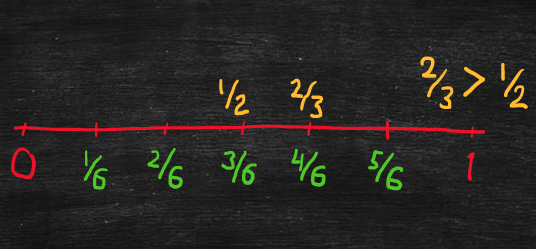Notes
In the following, “A/B” represents the fraction “A over B.” For example, “2/3” refers to the fraction “2 over 3” or “two-thirds.”
A number line is a useful tool for comparing fractions to determine which of two fractions is greater. For example,
- To compare 1/2 and 2/3, we need to express the fractions using a common denominator.
- A common denominator for 2 and 3 is 6, and 1/2 = 3/6 and 2/3 = 4/6.
- Draw a number line between 0 and 1, divide the line into sixths, and mark 1/2 = 3/6 on the third tick mark and 2/3 = 4/6 on the fourth tick mark.
- Thus, 2/3 > 1/2.

For another example,
- To compare 5/8 and 3/4, a common denominator for 8 and 4 is 8, and 5/8 does not change, while 3/4 = 6/8.
- Draw a number line between 0 and 1, divide the line into eighths, and mark 5/8 on the fifth tick mark and 3/4 = 6/8 on the sixth tick mark.
- Thus, 3/4 > 5/8.
For another example,
- To compare 5/6 and 3/4, a common denominator for 6 and 4 is 12, and 5/6 = 10/12, while 3/4 = 9/12.
- Draw a number line between 0 and 1, divide the line into twelfths, and mark 5/6 = 10/12 on the tenth tick mark and 3/4 = 9/12 on the ninth tick mark.
- Thus, 5/6 > 3/4.
The video below shows how to use number lines to compare fractions.
Video Tips
Practice Exercises
Do the following exercises to practice ordering fractions. Visualize the fractions on a number line to help you determine where to place the fractions in order from least on the left to greatest on the right.

